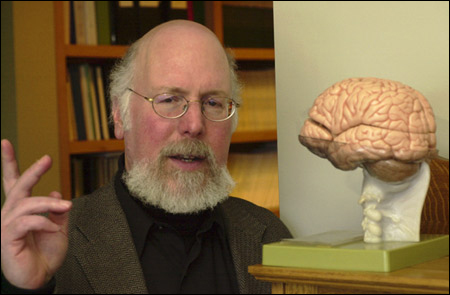Thought of pain changes the brain
Dummy pill makes it hurt less – for real

Scientists have found that beliefs and expectations can reduce pain.
The researchers used imaging techniques to watch the brain as it prepared for, then received, jolting electric shocks or distressful heat. Activity in the pain centers of those given a phony anesthetic cream turned out to be significantly less than in the brains of those who didn’t get the “treatment.”
The researchers were trying to determine whether such dummy treatments, called placebos, actually reduce pain or whether they only lead people to say they feel better. In one experiment, 24 volunteers had a placebo cream rubbed on their wrists and 23 others did not. All of them underwent functional magnetic resonance imaging (fMRI) before and during distressing but not harmful electric shocks. A second experiment with different participants involved a distressing amount of heat. In both cases, those who were creamed reported less pain than those who were not.
The fMRI scans backed them up, revealing significant reductions in the activity of pain-sensitive areas of the brain. The same scans also showed increased activity in parts of the brain that deal with anticipation.
“These results provide strong evidence that the placebo effect is real, and not just a bias connected with a suggestion that they’d feel better,” says Stephen Kosslyn, a professor of psychology at Harvard who helped design the experiments. “We believe that heightened activity in the frontal lobes of the brain, which deal with organizing information, sends messages that decrease activation in pain-sensitive areas. We now have a foundation for further experiments to test whether or not we can teach people to enhance their reaction to placebos. That’s really exciting!”
Customizing pain
But there’s something scary in it, too. Sometimes doctors, wanting to be completely honest, tell patients that, “there’s nothing more we can do for you.” That’s known as a “nocebo.” “Placebo” is Latin for “to please”; nocebo is bound to displease.
“Our data suggest that a nocebo could affect the brain in a negative way,” Kosslyn notes. “Could it increase the expectation of dying, reduce the will to live? We don’t know the answer, but we now have the technology that allows us to get a grip on this and other issues that could only be considered speculation just a few years ago.”
The thought-bending studies involved a collaboration between Kosslyn and researchers at the universities of Michigan, Princeton, Wisconsin, and Texas, who published their results on Feb. 20 in Science magazine.
The report does not completely answer the question of how a placebo works. It does mention two possibilities, however. The frontal lobes (behind the forehead) can divert the brain’s attention from its pain centers. Alternatively, they could send messages to a place in the middle of the brain where natural painkillers are released. These comforting chemicals, known as opioids, are responsible for such things as the high felt by long distance runners.
The researchers did record activation in the opioid-releasing area during their experiments, but Kosslyn feels the placebo effect probably involves both mechanisms. This is another issue that requires more studies to resolve. “Such experiments are expensive,” Kosslyn points out, “so they hinge on the where and when of funding.” Funds to date came from the Mind, Brain, Body Health Initiative, which grew out of an earlier program supported by the John D. and Catherine T. MacArthur Foundation of Chicago.
Surprise in timing
The research team anticipated that the frontal lobes and pain-sensitive areas of the brain would take part in placebo action. But the timing was unexpected. “We were surprised that the placebo has its effect relatively late after application of the shocks or heat,” Kosslyn notes. “It was not like flipping a light switch – activity in the pain sensitive parts of the brain took a few seconds to decrease.”
Evidently, the brain starts to respond to pain, then that activity is dampened by signals from the frontal lobes. This would account for the increased activity behind the forehead. Apparently, the lobes need some time to act on expectation that the phony cream would work – some time to shift attention away from the pain or/and to stir up opioid activity.
“With more understanding of how the effect works, we should be in a position to manipulate it,” Kosslyn says. Amplifying placebo action might provide a natural painkiller, free from the unwanted side effects of many medications. It also could shed light on the possible dark effects of nocebos.
“Such understanding should have direct implications for how physicians interact with their patients,” Kosslyn believes. “And it could impact the testing of new drugs.”
When testing drugs, investigators give some participants the real thing and some get dummy pills for comparison of efficacy. But, as these new studies show, placebos boast effects beyond mere suggestion, at least in the case of pain. Some researchers believe that placebo effects make as many as one of every three patients feel better whether they get a new drug or not. If so, to find out how a drug really works would require three rather than only two sets of subjects.




